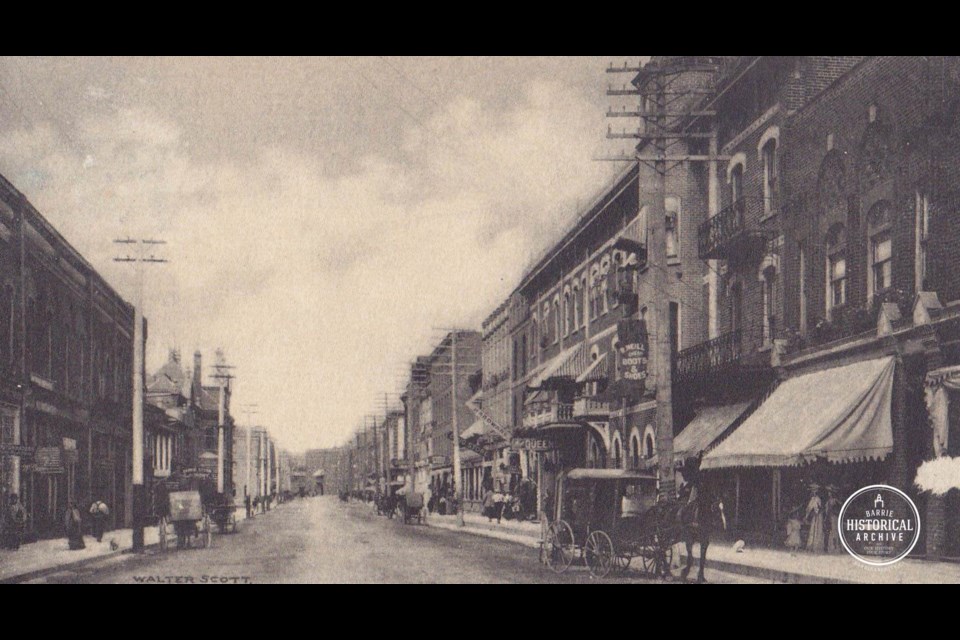“The splendid situation of the House, fronting on the beautiful Bay of Kempenfeldt – the salubrity of the air – the purity of the water – all combine to render this spot one of the most healthy and delightful! Summer retreats, and the Northern Railroad now places it within three hours of Toronto.”
Henry Fraser, proprietor of the Queen’s Hotel, placed this ad in the Northern Advance of July 14, 1856. At that time, the railway had not yet come around the bay to Barrie but instead ended at Allandale, which was nevertheless considered a great convenience.
In 1860, Henry Fraser advertised that his hotel was being greatly enlarged and improved. Below it, an ad for the Barrie Hotel listed Daniel Faragher as the proprietor of that establishment.
What might not be fully understood is that the present-day Queen’s Hotel, now operating under that name for about 100 years, is not the original one. The first Queen’s Hotel was farther east, almost at Mulcaster Street. It occupied the block that today spans 110 Dunlop St. E., over to the west wall of 118 Dunlop St. E. A distinct absence of Victorian architecture can be observed in that section.
The Queen’s Hotel of today is actually the Barrie Hotel of old.
In 1873, the Barrie Hotel added 30 new guest rooms and boasted that this addition was entirely brick. Brick was expensive in those days. All of the original business blocks in downtown Barrie had originally been roughcast and wood frame.
Only after they were lost to fire, one after the other, did downtown business buildings rebuild in brick, but the Barrie Hotel was obliged to do so by an 1871 bylaw prohibiting any more wood construction. Its neighbour to the west, the McConkey building, had put up a fire wall during its 1866 construction, which saved the Barrie Hotel and its neighbours to the east on more than one occasion.
In 1909, the issue of the value of the Queen’s Hotel came up and had to be sorted out in court. Many in town thought it was being overvalued both in both real property and for fire insurance purposes. Since the introduction of ‘the local option’ (a temperance law), local hotels, including the Queen’s Hotel, had depreciated in value. In the end, it was judged to be worth the assessed value of $31,000.
The hotels of Barrie could no longer rely solely on alcohol sales for their livelihoods and so the newspapers were filled with ads for events that focused more on the dining aspect of the business, live auctions, music, visits from travelling salesmen and meetings.
In 1913, both the Queen’s and Barrie Hotel advertised some upgrades. The newspapers reported that the Queen’s got some new wallpaper and mattresses while the Barrie Hotel added a new roof, a verandah and wallpaper.
By 1914, the Lake Simcoe Hotel Company was the owner of the Queen’s Hotel. The hotel had recently been assessed at $38,000. In December of that year, the fire department was called to the Queen’s for non-destructive fire. No real damage was done to the hotel, but Fire Chief George Smith dropped dead from a sudden heart attack while attending the scene.
A truly destructive fire came two months later in February 1915 and burned the entire Queen’s Hotel block to the ground. The blaze began about two o’clock in the morning in Cudmore’s newly opened discount store which occupied part of the hotel.
The fire department was there quickly and had no doubt that they were meeting with success until flames, which had been quietly travelling up interior wooden joists, shot from the upper windows. From then, the blaze was in control. The fire-proof roof was of no consequence when its supports disintegrated and it collapsed inwards with a deafening crash.
What followed was more than 10 years of legal wrangling that saw much of the charred remains of the Queen’s Hotel remaining and causing a great eyesore. Iron salvage men came and removed any metal of value, part of a ruined store was torn down to make way for another that was never built, Dunlop Street East business people complained that the mess of ugly rubble had sent their customers elsewhere, but nothing else seemed to change.
The Lake Simcoe Hotel Company, in 1915, believed their post-fire property was worth at least $13,000 and turned down an early offer of $10,000. After years of back and forth, debates over land value, and taxes piling up, the town took over the property in 1926.
Soon thereafter, they got an offer from Franklin ‘F.W’. Livingston for $1,600. The town wanted $2,000 to cover the tax arrears, which Livingston eventually agreed to. He then built an auto dealership at 110 Dunlop St. E., that still stands today, and later a bowling alley and an Eaton’s store. The latter two burned in 1966.
Amazingly, during the clean-up of the old hotel site, workmen discovered three bottles of champagne and two bottles of scotch whisky, all undamaged.
Each week, the Barrie Historical Archive provides BarrieToday readers with a glimpse of the city’s past. This unique column features photos and stories from years gone by and is sure to appeal to the historian in each of us.



